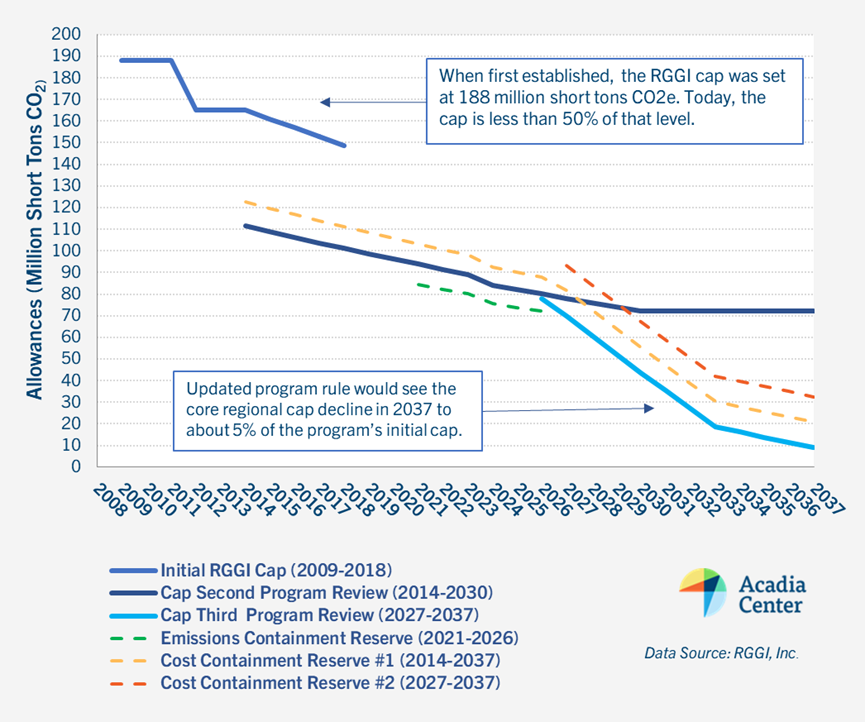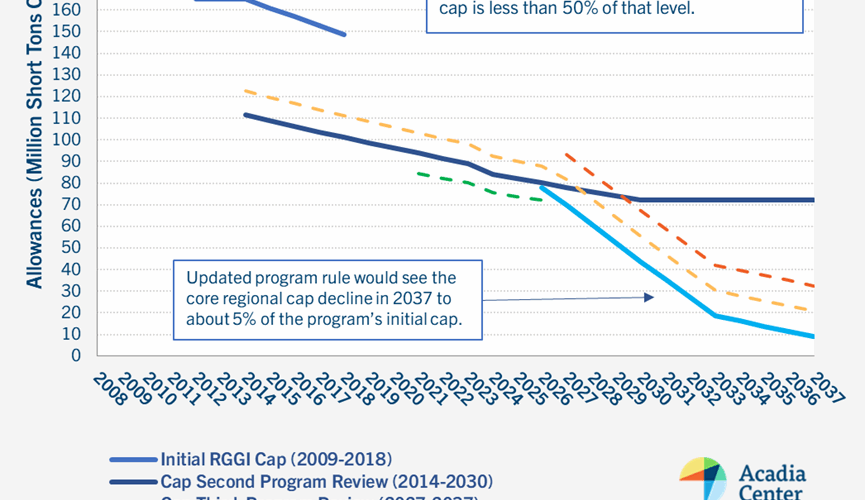FOR RELEASE: RGGI States Finalize Program Updates to Support Clean Air and Affordable Energy through 2037
MEDIA CONTACTS
Paola Moncada Tamayo
Senior Policy and Data Analyst
ptamayo@acadiacenter.org; 860-246-7121 x204
Jamie Dickerson
Senior Director, Climate and Clean Energy Programs
jdickerson@acadiacenter.org; 401-276-0600 x102
ROCKPORT, ME – On Thursday, July 3, 2025, the ten states participating in the Regional Greenhouse Gas Initiative (RGGI) announced the conclusion of the program’s Third Program Review, finalizing a long process for updates aimed at reinforcing the region’s power sector transition and related climate and energy affordability goals. The agreement by the states will allow for the program’s benefits to continue through 2037, which to-date have brought $20 billion in energy bill savings through the investment of proceeds. RGGI has proven the power of multi-state collaboration, and the continuation of the program will ensure steady investments to benefit consumers, address energy affordability, support communities, and increase economic output. The agreement includes several important changes to strengthen and future-proof the program for consumer and community benefits, including: a strengthened emissions cap through 2037, new market mechanisms, the removal of offsets for program compliance, and a commitment to continued progress. Acadia Center applauds the RGGI states and RGGI, Inc., for bringing this updated model rule to fruition during a period of unprecedented uncertainty.
“RGGI has long demonstrated its effectiveness in providing consumers with large benefits in energy savings and investments in a cleaner future” said Daniel Sosland, president of Acadia Center. “RGGI program improvements reflect the power of bipartisan states’ cooperation to work together toward a cleaner energy future. We look forward to supporting their efforts as they move into the implementation phase and ensuring that the benefits of this program reach households and communities across the region.”
The conclusion of the program review and associated updated model rule bring clarity to several important program and market mechanisms that affect the program’s operation and its resulting impacts to power plants, communities, consumers, and other stakeholders. The program mechanisms described below will work together not only to reduce detrimental pollution that harms public health, but also to enhance the program’s ability to keep delivering tangible financial and energy benefits to consumers and the public.
Key Program Updates:
- Stronger Emissions Cap: Beginning in 2027, the new regional cap puts the ten states on a declining trajectory to reach just under 10 million tons of carbon dioxide equivalent (CO2e) emissions from the power sector by 2037, down from a cap of 82 million tons of CO2e emissions today and a cap of 188 million tons CO2e when the program first held auctions in 2008. Backed by state policy and consistent market direction, it is a positive step forward that demonstrates a strong, multi-state commitment to grid decarbonization.
- Removal of Offsets: Historically, the RGGI program has allowed power generators to use offset allowances representing GHG reductions achieved outside the power sector (e.g., avoided agricultural methane) to meet their emission reduction requirements. RGGI will no longer issue offset allowances beginning in 2027, simplifying program design and reinforcing the focus on direct emissions reductions in the power sector.
- A New Cost Containment Reserve Market Mechanism: A two-tier Cost Containment Reserve (CCR) will be instituted with the objective of helping manage cost volatility while maintaining cap integrity across the ten-state region.
- Minimum Price Floor: The existing Emissions Containment Reserve (ECR) will be replaced by a higher minimum price floor, set at $9 in 2027 and increasing by 7% annually, ensuring RGGI sends a stronger lower bound price signal to power generators.
The updated Model Rule provides the framework for each participating state to revise its own rules through legislative or regulatory processes, with the goal of implementing these changes by January 1, 2027.

Since the first auction in 2008, RGGI has steadily evolved through three program reviews to become an effective policy tool for emission reductions and regional collaboration. The chart above illustrates how the emissions cap has tightened significantly over time, from an initial 188 million tons to a projected 10 million tons in 2037. The new cap trajectory from the Third Program Review sends a strong signal to markets and power providers that the decarbonization of the power sector is not only possible but already underway across the region and expected to continue, irrespective of countervailing changes at the federal level.
Acadia Center’s full set of Findings and Recommendations for the Third Program Review Report helped shape the discussion by offering proposals to strengthen program impact, enhance equity in proceeds spending, and address other longer-term elements of the program’s evolution.
A Proven Track-Record of Success
RGGI is the United States’ first multi-state program designed to reduce pollution from power plants, providing significant benefits for the participating states and their consumers and communities. Since its inception, RGGI has contributed to nearly 50% reduction in CO₂ emissions from covered power plants. The program has generated over $9 billion in proceeds, which states have invested in clean energy, energy efficiency, and bill assistance programs that benefit local communities and consumers.
RGGI announced that program investments have directly benefited more than 8 million households and 400,000 businesses and are expected to save ratepayers over $20 billion on energy bills. A recent analysis by Acadia Center, RGGI Proceeds in Action, highlights in further detail how states have used these investments to deliver benefits to communities and consumers, along with recommendations for improved reporting and proceed investments.
Looking Ahead
As part of this announcement, the RGGI states have committed to launching a Fourth Program Review no later than 2028. This future review will assess the performance of the newly adopted changes, consider additional adjustments as needed, and further explore opportunities to ensure a reliable, equitable, and clean electricity system across the region.
The updated framework also leaves the door open for future participation by additional states, which would bring greater economic efficiency and climate benefit to the region as a whole.
The graph above focuses on the cumulative RGGI cap over the 200-2037 time period for the ten states that currently participate in RGGI and assumes New Jersey did not exit the program from 2012-2019 for the sake of visual clarity.



















